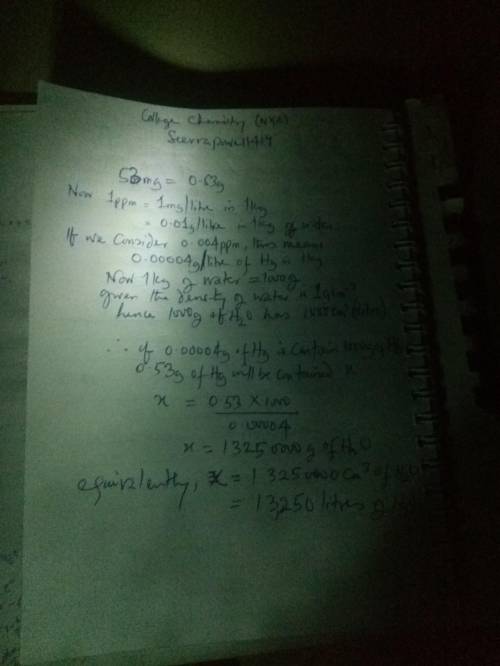
The Safe Drinking Water Act (SDWA) sets a limit for mercury-a toxin to the central nervous system-at 0.002 ppm by mass. Water suppliers must periodically test their water to ensure that mercury levels do not exceed this limit. Suppose water becomes contaminated with mercury at twice the legal limit (0.004 ppm). How much of this water would have to be consumed for someone to ingest 53 mg of mercury?

Answers: 3
Other questions on the subject: Chemistry

Chemistry, 21.06.2019 23:30, huangjianhe135
Start an single atom tab. observe the decay of polonium-211. after each decay, press the reset nucleus button to watch the process again. write a description of alpha decay for po-211
Answers: 2


Chemistry, 22.06.2019 21:20, paatnguyyen
One way in which the useful metal copper is produced is by dissolving the mineral azurite, which contains copper(ii) carbonate, in concentrated sulfuric acid. the sulfuric acid reacts with the copper(ii) carbonate to produce a blue solution of copper(ii) sulfate. scrap iron is then added to this solution, and pure copper metal precipitates out because of the following chemical reaction: (s) (aq) (s) (aq) suppose an industrial quality-control chemist analyzes a sample from a copper processing plant in the following way. he adds powdered iron to a copper(ii) sulfate sample from the plant until no more copper will precipitate. he then washes, dries, and weighs the precipitate, and finds that it has a mass of .
Answers: 2

Chemistry, 23.06.2019 12:00, imaboss10986
In ccl4 is there a certain length that the main atom carbon is a certain distance from the chlorine’s?
Answers: 1
Do you know the correct answer?
The Safe Drinking Water Act (SDWA) sets a limit for mercury-a toxin to the central nervous system-at...
Questions in other subjects:

Mathematics, 13.06.2021 04:40









Mathematics, 13.06.2021 04:40







